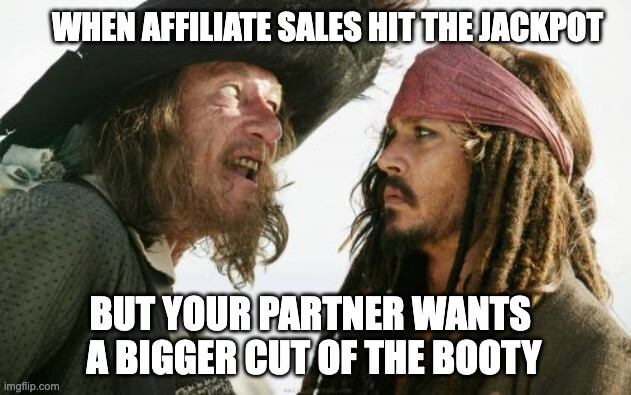The global affiliate marketing industry is worth $18.51 billion and is projected to grow to $27.78 billion by 2027, with over 80% of brands now using affiliate programs to boost their sales. Affiliate marketers drive between 15-30% of all online sales for businesses, and companies see an average return of $12 for every $1 invested in affiliate marketing campaigns.
Affiliate marketing in layman’s terms
In a nutshell, here’s what “affiliate marketing” is all about:

Yep, I don’t work for free. Neither do you.
We’re not some noble charity organization. We have to put food on the table for ourselves and our family, yes?
Affiliate marketers get paid by recommending other brands’ products and services. That’s how they pay the bills and then some.
Me here at CartMango? My small team and I will also eventually recommend some good shyt (from external brands) to our cool audience (YOU)…
But for now, I’ll only recommend my own CartMango (if you’re a course creator, coach, expert, or consultant selling digital offers and/or online services).
Key affiliate marketing stats
- The most popular payment model is Cost Per Action (CPA) with a staggering 99% of programs using this structure.
- In 2024, the global affiliate marketing sector is valued at USD 18.51 billion. The market size is projected to reach USD 27.78 billion by 2027.
- Over 80% of brands have affiliate programs to boost their digital marketing campaigns.
- Affiliates drive between 15% to 30% of online sales for advertisers.
- Retail companies generate 44% of all affiliate marketing revenue.
- Amazon Associates recorded $1.28 billion in revenue through their affiliate program in Q1 2023.
- The favorite traffic source is Search Engine Optimization (SEO) — 69% of affiliates employ this strategy.
- The affiliate marketing industry is set to expand in emerging markets, with Asia Pacific expected to grow at 14% CAGR (Compound Annual Growth Rate) from 2021 to 2026.
Commissions ($)
- 48.9% of affiliate marketing programs offer flat-rate payments.
- A slightly lower percentage — at 42.4% — are percentage-based, while less than 5% use other forms of incentives.
- The most popular payment model is Cost Per Action (CPA) with a staggering 99% of programs using this structure.
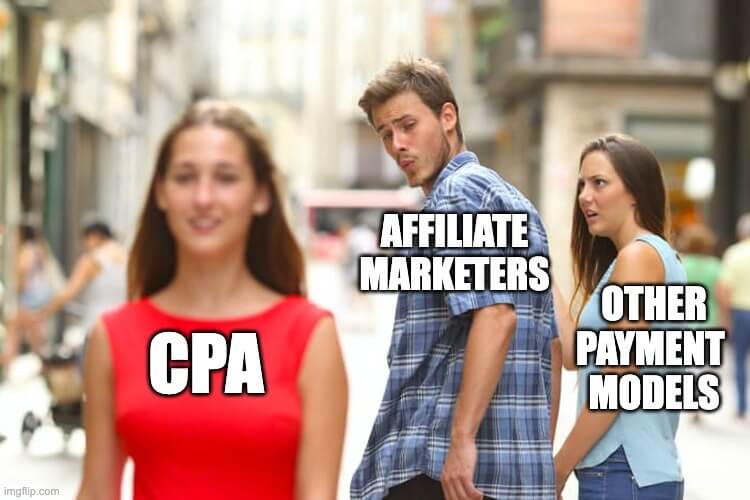
- Affiliate commissions range between 5% – 30%. However, these numbers can vary based on the industry and nature of the offer being promoted. For example:
- Retail and eCommerce: 5% – 15%
- Digital products and software: 20% to 50% (high percentage thanks to their profit margins)
- Travel and hospitality: Between 4% – 10%; luxury services may offer higher rates
- Financial services: Commissions are usually per lead (rather than per sale), with amounts ranging from $50 to $200 per lead.
- Health and well being: 15% commissions is common
Sources: Influence Marketing Hub, IAB, Up Promote, World Metrics
Market share
- In 2024, the global affiliate marketing sector is valued at USD 18.51 billion. Market trends project it to reach USD 27.78 billion by 2027.

- Here’s a breakdown of this number by region:
- North America: USD 7.40 billion, with a Compound Annual Growth Rate (CAGR) of 6.2% from 2024 to 2031
- Europe: USD 5.55 billion, with a CAGR of 6.5% from 2024 to 2031
- Asia Pacific: USD 4.26 billion, with a CAGR of 10% between 2024 to 2031
- South America: USD 0.93 billion, with a CAGR of 7.4% from 2024 to 2031
- Middle East and Africa: USD 0.37 billion, with a CAGR of 7.7% from 2024 and 2031
Sources: Cognitive Market Research, Proficient Market Insights
Demographics
- Age: The biggest age range group is 35 – 44. They make up 32% of the affiliate marketing community. Next are individuals aged 25 – 34, accounting for 28%.
- Gender: Males at 54% while females represent 43%.
- Marital status: Just over half (55.32%) of affiliate marketers are married.

- Experience: 40% have over 5 years of experience in the industry.
Sources: Up Promote, Tech Report, Web Tribunal
Adoption & popularity
- Over 80% of brands have affiliate programs to boost their online marketing campaigns.
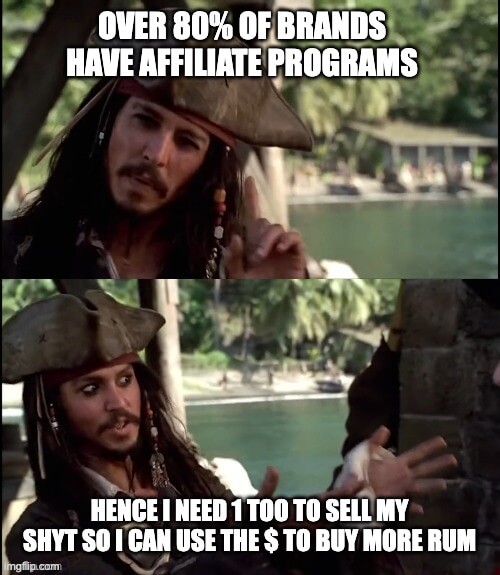
- In the United States, affiliate marketing contributes to 16% of all online purchases.
- Since 2016, the phrase “affiliate marketing” has seen a 44% increase in search queries.
Sources: Forrester, Awin, Google Trends
The impact of affiliate marketing on online retail
- The average affiliate marketer drives between 15% to 30% of online sales for advertisers.
- Retail companies generate 44% of all affiliate marketing revenue.
- For every dollar invested in affiliate marketing campaigns, businesses see a return of $12 (i.e a return on investment of 1,100%).
- Amazon Associates recorded $1.28 billion in revenue through their affiliate program in Q1 2023.
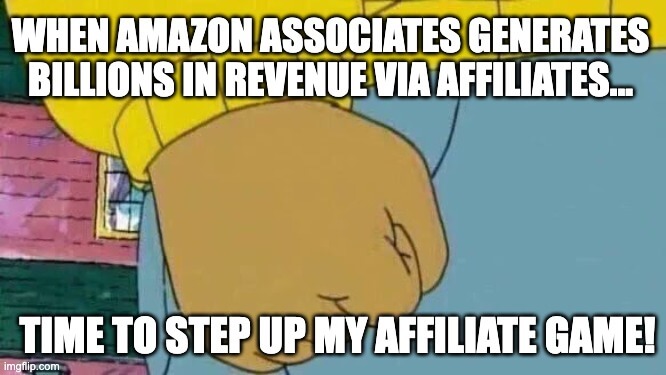
- Distribution of online GMV (Gross Merchandise Volume) across different companies worldwide:
- Alibaba: 23%
- Amazon: 12%
- JD.com: 9%
- Pinduoduo: 8%
- TikTok: 4%
- Other: 4%
- Walmart: 1%
- eBay: 1%
- Shopee: 1%
- Apple: 1%
- Rakuten: 1%
- Rest: 35%
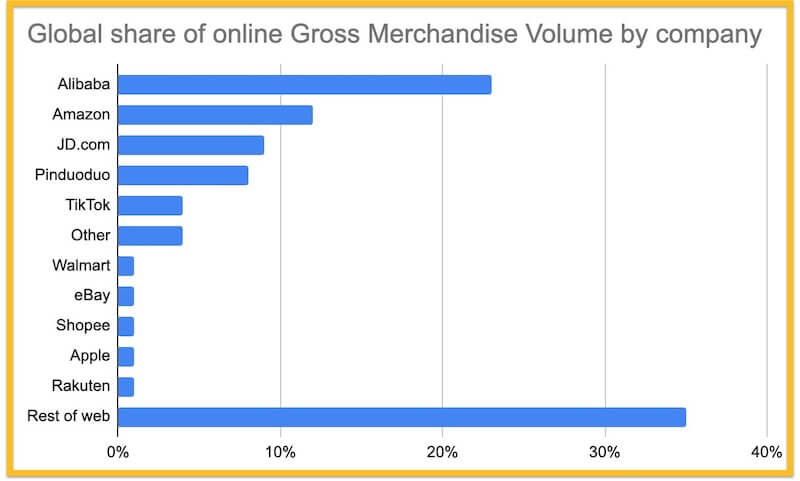
Sources: Uniqodo, Influencer Marketing Hub, Performance Marketing Association, Amazon Associates, Red Stag Fulfillment
Why mobile users matter
- Mobile affiliate marketing is expected grow by 19% YOY (year-over-year).

- Nearly half (45%) of all affiliate marketing traffic comes from mobile devices.
- Conversion rates for mobile users have risen by 30% over the past year.
- By 2025, over 10% of all retail sales in the US will be driven through mobile devices.
Sources: CJ, Awin, Rakuten Advertising, Statista
Marketing channels
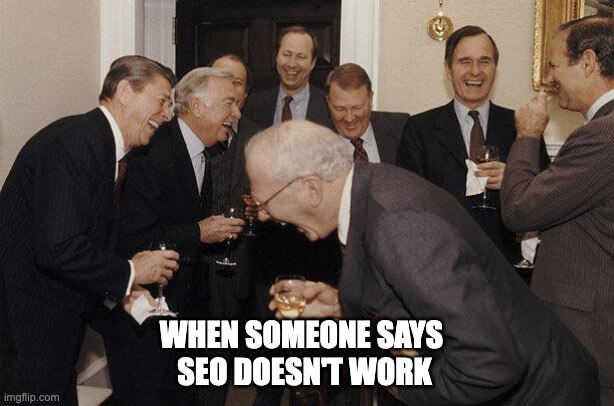
- The most popular digital marketing strategy is content creation via Search Engine Optimization (SEO) — 69% of affiliates employ this strategy to drive sales.
- Next is social media marketing through Facebook, Instagram, and YouTube where folks create both text and video content — 65% leverage these for exposure.
- Email marketing is also highly valued — 41% of affiliate marketers rely on emails to promote offers to their customer base.
- 38% of affiliates collaborate with social media influencers to expand their reach and connect with potential customers and consumers.
Sources: Awin, Statista, Influencer Marketing Hub, Rakuten Advertising
Challenges in affiliate marketing

- Businesses lose an estimated $1.4 billion annually to fraudulent activities.
- Around 38% of affiliate-referred traffic is deemed invalid or fraudulent.
- The most common types of affiliate marketing fraud are cookie stuffing, click fraud, and fake leads. Click fraud alone contributes to 36% of these activities.
- 40% of companies express confidence in their capabilities to detect and prevent affiliate fraud.
- Businesses lose 10% of their revenue due to affiliate marketing fraud.
Sources: Statista, Forrester, Rakuten Advertising, PerformanceIN, Impact
Future trends & predictions
- The affiliate marketing sector is projected to grow at a compound annual growth rate (CAGR) of 8% from 2024 to 2031… indicating promising growth opportunities ahead.
- By 2025, 60% of affiliate marketers will leverage artificial intelligence (AI) and automation tools to optimize their campaigns and efficiency.
- The affiliate marketing industry is set to expand in emerging markets, with Asia Pacific expected to grow at 14% CAGR (Compound Annual Growth Rate) from 2021 to 2026.
- With privacy regulations on the rise, 70% of affiliates plan to focus on first party data to improve targeting and personalization.

Sources: Cognitive Market Research, Forrester, Mordor Intelligence, eMarketer
Success stories
- The Points Guy
- A travel website that promotes credit cards and travel bargains in exchange for affiliate commissions as a revenue source.
- It’s grown into a multi million dollar business with a huge portion of its income from affiliate collaborations with credit card companies.
- Amazon Associates
- Amazon Associates is one of the largest and most successful affiliate programs globally. Many affiliates earn a nice income by promoting Amazon goods.
- Pat Flynn from Smart Passive Income earned over $100,000 in a single year through its program.
- NerdWallet
- NerdWallet is a finance site that uses affiliate marketing to promote financial products like credit cards and loans.
- It has amassed more than $150 million in revenue
These real life examples and success stories prove that affiliate marketing can work for both brands and individuals in different sectors.
Sources: CBNC, The Points Guy, Smart Passive Income, Amazon Associates, Business Insider
Top 6 Affiliate Networks
1/ Amazon Associates
Amazon Associates is an affiliate program known for its huge range of products and easy integration, making it a solid choice for affiliate marketers.
2/ CJ
CJ — previously known as Commission Junction — is one of the standing affiliate networks with a diverse pool of advertisers and competitive commission rates.
3/ Rakuten Advertising
Rakuten Advertising provides affiliates with access to luxury brands.
4/ Clickbank
ClickBank is for a niche audience — specifically for promoting digital products such as ebooks and online courses. It offers generous commissions that can go as high as 75%. Its user friendly interface makes it appealing.
5/ Awin
Awin boasts a presence with diverse affiliate programs across different industries. Their tracking technology, advertiser network, and dedicated support set them apart.
6/ Share A Sale
ShareASale is renowned for its variety of merchants spanning across many profitable niches and dependable tracking mechanisms.
The top 5 most profitable affiliate niches

1/ Wealth and Finance
- This is the highest-paid niche that pays up to $100 per lead.
- In 2021, the market size was $22.5 trillion. It’s expected to grow at a CAGR (Compound Annual Growth Rate) of 6%.
Folks with money want their money to work harder for them. No surprise this is the #1 niche.
Sources: Business Insider, Grand View Research
2/ Health and Wellness
- Running in 2nd place is the Health and Wellness niche, valued at $4.5 trillion.
Folks not only want to be healthy, they want to be in great shape and look great too. If you can satisfy these needs. That’s why the health and wellness niche is in high demand and pays good ommissions.
Source: Global Wellness Institute
3/ Technology
- This sector includes both software and gadgets. It has already reached $507.2 billion in 2021 and shows no signs of slowing down.
Netflix, Spotify, ChatGPT, Canva — we now live in a world run by software subscriptions, and it seems many folks can’t live without them. Sell a subscription once and you get paid recurring commissions every month.
Source: Statista
4/ Education
- Projected to reach $374.3 billion by 2026.
Thanks to the internet and technology, online learning is as easy as opening your phone. Anyone can learn from anywhere. No more excuses. There’s never a better time to promote online education courses as an affiliate and earn some nice $.
Source: Global Market Insights
5/ Lifestyle and Hobbies
- We’re talking travel and gaming. In 2022, this niche reached $196 billion and is expected to grow even higher.
Everyone needs to chill and take a break, and this sector provides a much-needed refresher for people.
Source: Newzoo
Conclusion
For decades, affiliate marketing has proven to be a source of serious revenue for brands and affiliate marketers.
Brands and affiliate marketers need each other.
The question is: regardless if you’re a brand or affiliate marketer — are you going to jump on the bandwagon or just stand on the sidelines cluelessly wondering “what happened”?
FAQ
What is affiliate marketing and how does it work?
Affiliate marketing is promoting other people’s offers (products and/or services) in exchange for commissions.
How can I start affiliate marketing with no money?
Most affiliate programs are free to join. The quality ones usually do a human review of your website before approving your application. However, the most successful affiliates have regular expenses like web hosting, video hosting, software, content creation, collaboration, etc. I suggest having a marketing budget if you want to turn it into a thriving ecommerce business.
How do I choose the right niche for affiliate marketing?
It depends on what your interests or expertise are, how much commissions you’re after (some niches pay more than others — e.g. real estate pays more than weight loss), and how much effort + time you’re willing to dedicate.
What are the common mistakes to avoid in affiliate marketing?
- Choosing low quality products — not only will you face backlash from customers, they’ll bad mouth you… resulting in a tarnished reputation.
- Solely relying on organic and/or paid traffic — you should also be building an email list of your own. This is your asset that nobody can take it away from. If Google changes its algorithm or Meta shuts down your ad account, you’ll always be able to drive traffic to any offer you promote.
- Promoting to the wrong audience — make sure the products and/or services you promote are what your target audience wants.
- Only creating “salesy” content all the time — treat others how you want to be treated. Create useful content too. Make them so useful that even though people don’t buy what you promote, they’re still in a better place than before they met you. Always spread goodwill. They might not buy now because of various reasons, but they might buy in the future. And if you keep showing up like a good, old trust friend… guess who’ll they buy it from?
- This last point is not an affiliate’s mistake per se, but if you can persuade the product vendor to set up abandoned cart emails to recover lost sales… everyone wins. The vendor gets a boost in revenue, you get an increase in commissions. Heck, you can even offer to write these emails for them by following my templates.
How do I track my affiliate performance?
The product/service vendor will give you a link that’s unique to you. This means other affiliates promoting the same offer will have their own unique affiliate links too.
So there will be no confusion as to who referred the traffic.
The vendor will also provide you with an account to log in to check your stats (traffic referred, which offers sold, how many sales, how much commissions, etc.)
What’s the average sales conversion rate?
0.5% – 1% according to Influencer Marketing Hub. This means for every 200 clicks to an offer sales page, you can expect 1 – 2 of them to convert to customers. This is an average since conversion rates can greatly vary from industry to industry.
Can you really make 6 figures with affiliate marketing?
Yes, but it’s not easy. Nothing worthwhile is easy. And you should treat this as a real business. Just because many successful affiliates run their affiliate marketing business online doesn’t mean “it’s just another online thing”.
You get what you put in.
Influencer Marketing Hub found:
- 3.78% of survey respondents earned $150,000+ annually from affiliate commissions
- 7.94% earned $100,000 – $150,000
- 5.15% earned $50,000 – $100,000
PS. If you’re into creating online courses, here are 200 online course ideas.
